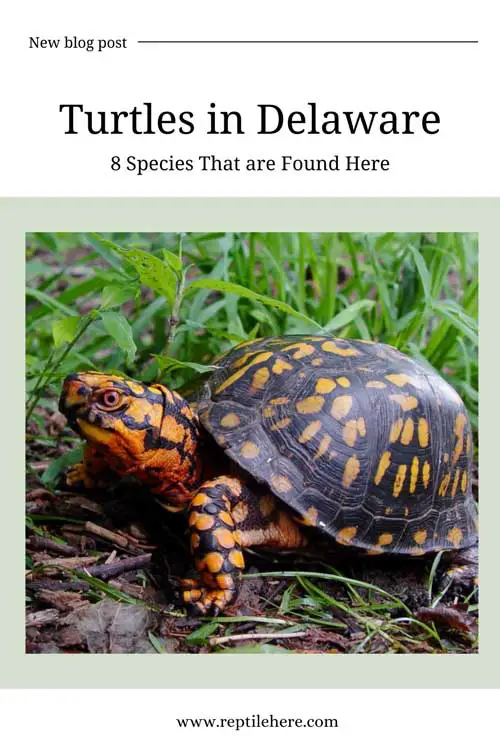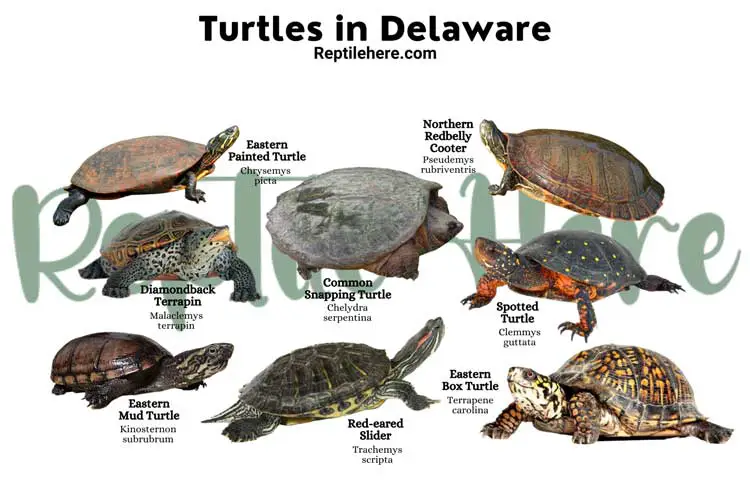Turtles in Delaware – 8 Species That are Found Here
Delaware is home to 8 native turtles. Most of them are aquatic species, including common snapping turtle, painted turtle, northern redbelly Cooter, diamondback terrapin, and more.
The freshwater species are widespread through the state’s marshes, ponds, rivers, lakes, and slow streams. They prefer water bodies with plenty of aquatic vegetation to provide cover and food to them.
Delaware is also home to the Eastern Box Turtle—the only terrestrial turtle species in the region.
In this article, we’re going to discuss all the species of turtles found in Delaware.
We’ll cover the basics of each turtle species like the physical appearance, average adult size, what they eat, where they live, lifespan, and conservation status.
8 Types Of Turtles In Delaware
Contents
1. Common Snapping Turtle

- Scientific name: Chelydra serpentina
- Common name: Snapping Turtle
- Family: Chelydridae
- Size: 8 to 18 1/2 inches
- Lifespan: 30 to 50 years or more
- Conservation status: Least Concern
Common snapping turtles are widespread throughout Delaware. An average adult is pretty large and has a shell length of 18½ inches long.
This species has a chunky head, a long tail, and large webbed feet. The shell color is black or olive and has no distinct pattern. These Delaware snapping turtles are known for their powerful jaws—they’re so strong that these turtles eat other turtles!
You’ll find them in waterbodies with muddy bottoms. Examples include marshes, ponds, lakes, rivers, and even shallow streams. They generally prefer waters with aquatic vegetation in plenty and foods such as fish, frogs, birds, etc.
These Delaware turtles generally show docile behavior but can get quite aggressive if taken out of water. The best way to calm it is to take it back to the waters, where it feels safe.
2. Eastern Painted Turtle
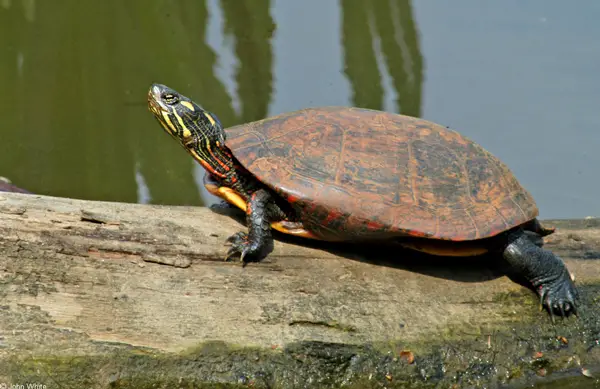
- Scientific name: Chrysemys picta
- Common name: Painted Turtle
- Family: Emydidae
- Size: 4 to 6 inches
- Lifespan: 30 to 50 years
- Conservation status: Least Concern
The Eastern painted turtle is one of the most recognizable turtle species in Delaware, thanks to its beautiful and unique coloring. The bright reds and yellow-green markings on its shell, head, and limbs are no doubt a beauty to behold!
This painted turtle sub-species in Delaware has been observed to live near water bodies with minimal movements. Examples include marshes, ponds, slow-moving streams with sandy/muddy bottoms, small lakes, etc.
They also prefer areas with aquatic plants in plenty as they make their primary food source in the wild.
One interesting fact about these Delaware turtles is their ability to hold their breath for up to 30 hours when inside temperate water. Moreover, they’re capable of standing dominant in freezing cold waters for up to 4 months.
Unfortunately, it’s not easy to establish the population of these turtles in Delaware. This is because most people who pet them end up releasing them back into the wild. This contributes to an ever-expanding range plus unstable reproduction rates for these turtles.
3. Diamondback Terrapin
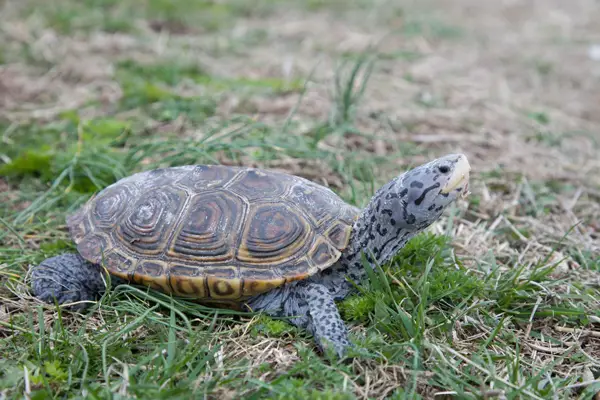
- Scientific name: Malaclemys terrapin
- Common name: Diamondback Terrapin, Mississippi Diamondback Terrapin
- Family: Emydidae
- Size: 4 to 6 inches (males), 5 to 8 inches (females)
- Lifespan: 25 to 35 years
- Conservation status: Vulnerable
The diamondback terrapin is the only freshwater species in Delaware that can adapt to saltwater as well. Their shells have a raised diamond shape, hence the name diamondback. The term “terrapin” simply means little turtle.
A typical diamondback terrapin in Delaware has black or brown carapace and yellow lower shell that may sometimes feature dark-colored patterns. The turtle’s skin is usually grey-white with multiple small black spots.
Female diamondback terrapins are usually bigger than their male counterparts.
These turtles are highly timid and can easily get stressed when in captivity. They’re pretty docile and can be handled. However, they’re known to bite as a way of defending themselves if they feel threatened.
Diamondback terrapins can be found along the coast in tidal flats, salt marshes, barrier beaches, and brackish streams in Delaware. They can also stay in full-strength saltwater for longer periods.
The terrapins are largely carnivorous and feed on crustaceans, fish, crabs, shrimps, marine snails, marine worms, mollusks, mussels, clams, and barnacles. However, they also tend to occasionally ingest small amounts of plant matter.
4. Northern Red-bellied Turtle
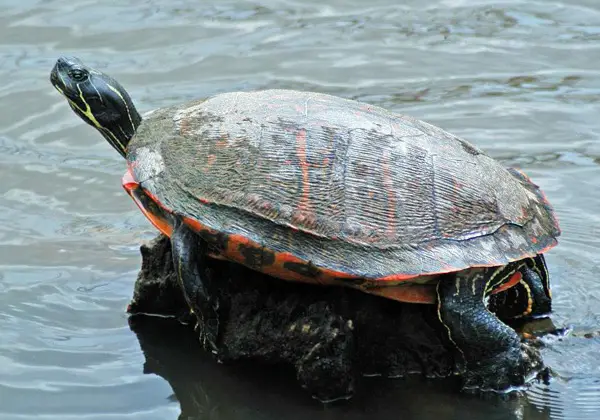
- Scientific name: Pseudemys rubriventris
- Common name: Northern Red-Bellied Turtle,American red-bellied turtle
- Family: Emydidae
- Size: 10 to 12 inches
- Lifespan: 40 to 60 years
- Conservation status: Not Threatened
As you can tell from its name, this species features a completely red (vibrant) plastron, sometimes covered with green spots. The turtle is known to live in freshwater streams, ponds, and lakes in Delaware.
And when the conditions allow, the turtle will venture into brackish streams near the Delaware coast.
A redbelly Cooter differs from other turtles with its head pattern which has lighter markings forming a distinct arrow shape, pointing toward the snout. The upper shell ranges form from dark brown to black.
Since the Northern redbelly turtles of Delaware are mainly herbivorous, they mostly feed on aquatic plants.
Note that this turtle species in Delaware face many threats including wetland loss, habitat loss, pollution, and collection for selling as pets.
At some point, this turtle was even sold for consumption (some countries still consume it even today!)
Also read: Turtles in Mississippi
5. Eastern Mud Turtle
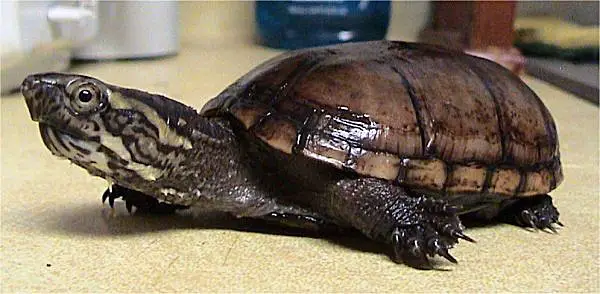
- Scientific name: Kinosternon subrubrum
- Common name: Eastern Mud Turtle, Mud Turtle
- Family: Kinosternidae
- Size: 3 to 5 inches
- Lifespan: 50 years
- Conservation status: Least Concern
The Eastern Mud turtle in Delaware is found in shallow waters including ditches, marshes, wet meadows, and swamps.
This smaller aquatic turtle species is characterized by a smooth and unmarked shell. Yes, it has an incredible plain look, with its upper shell lacking any patterns. The carapace color ranges from dark yellow to black.
The lower side of the shell is also pretty plain, though it usually appears lighter on the upper part. The key distinction of this mud turtle is the stripes on its head which can be white or yellow in color.
One particular feature that sets this turtle apart from others and makes it easily identifiable is the hinges on its lower shell which form a “K” shape when viewed from the sides.
Just as its name suggests, this turtle lives in water bodies with a soft muddy, or sandy bottom. Thus, they can be found in marshes, swamps, and rivers in Delaware.
Since this Delaware mud turtle is omnivorous, it eats meat, fish, snails, insects, and aquatic vegetation as well as plant matter on land.
Unlike other turtles, eastern mud turtles do not hibernate in the cold winter months. Instead, it does the opposite—it becomes dormant in the hot months of summer (this is known as aestivation).
6. Red-eared Slider
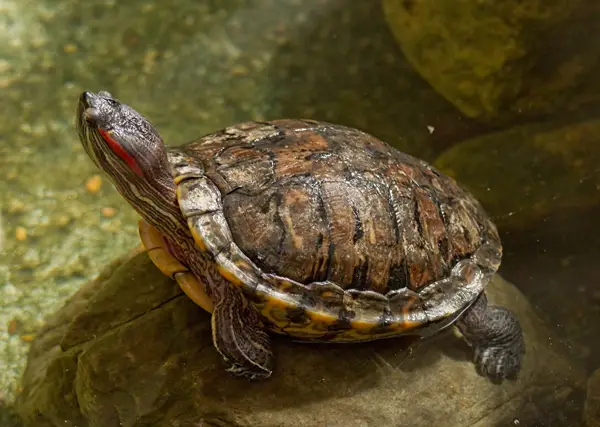
- Scientific name: Trachemys scripta
- Common name: Red-eared Slider, Red-eared Terrapin
- Family: Emydidae
- Size: 7 to 11 inches
- Lifespan: 30 to 40 years
- Conservation status: Least Concern
The red-eared slider is a sub-species of pond sliders and a native species of Delaware. It is a semi-aquatic turtle and prefers living in marshes, ponds, lakes, and creeks.
A red-eared slider gets its name from the small red stripe surrounding its ears (or behind the eye), and its ability to quickly slide off logs and rocks into water.
Generally, the skin and shell coloration of this slider can be brown or black, with yellow stripes covering the skin.
The red-eared sliders of Delaware are pretty large and the adults reach 7-12 in length (though females are generally larger than males).
These Delaware pond sliders are omnivorous and like eating fish, snails, insects, and aquatic vegetation. They also eat land vegetation, including fruits and vegetables.
7. Spotted Turtle
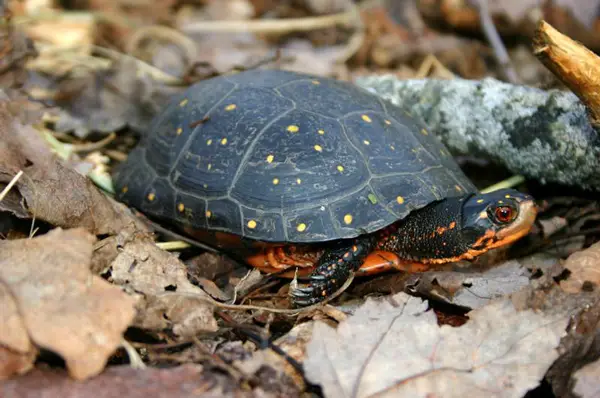
- Scientific name: Clemmys guttata
- Common name: Spotted Turtle
- Family: Emydidae
- Size: 4 to 5 inches
- Lifespan: 25 to 50 years
- Conservation status: Endangered
The Spotted turtles in Delaware reside in shallow marshes, swamps, and bogs. They’re semi-aquatic and are comfortable on land just as they are in the waters.
An adult spotted turtle has a smooth upper shell that ranges from olive to dark brown in color, with some light yellow spots. The neck and head feature irregular orange or yellow spots and streaks. Their tails are fairly long.
The turtles are omnivorous and their diet involves crustaceans, mollusks, insects, and plant matter (occasionally). Note that these turtles are aggressive hunters and will actively seek their prey.
Unfortunately, the population of spotted turtles in Delaware is on the decline due to human interference and habitat loss. Their unique shell patterns make them a favorite species of a pet turtle for many people.
For this reason, they’re listed as endangered and protected by many governing bodies, including Delaware authorities.
Above all, the spotted turtles of Delaware are incredibly smart. Studies carried on them using a maze even indicate that they have the same brain capacity as the mouse!
8. Eastern Box Turtle
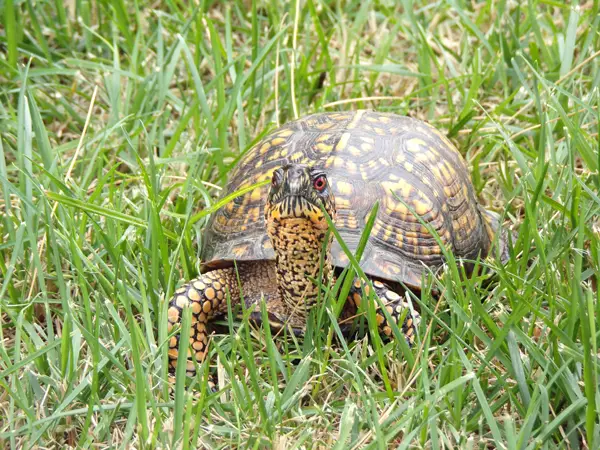
- Scientific name: Terrapene carolina carolina
- Common name: Eastern Box Turtle, Land turtle, Box Turtle
- Family: Emydidae
- Size: 4.5 and 7 inches
- Lifespan: 50 to 100 years
- Conservation status: Vulnerable
The eastern box turtles of Delaware are found in dense thickets and woodland areas. They prefer these areas due to abundant access to sunlight and food sources nearby.
An adult turtle of this species is about 4.5 to 7 inches and weighs just 2lbs. It has a high, domed shell shape with a ridge running from head to toe. The shell of this turtle has varying colors of olive, brown, and tan.
The variation in markings on the shells of these turtles is so variable that you can’t easily recognize one by looking at the shell alone.
These eastern box turtles of Delaware are omnivorous and feed on a variety of foods including insects, meat, fruits, vegetables, and various types of vegetation.
Note that eastern box turtles are taken from the Delaware wild for the pet trade, leading to a decline in their population. For this reason, many states have illegalized capturing and selling of this species.
And those in captivity end up dying due to poor conditions or being abandoned or released back into the wild because they’re too demanding to maintain.
Related: Turtles in Massachusetts
Conclusion
These are the 8 turtle species native to Delaware state. As you have seen from this list, most of the turtles that inhabit this state are freshwater species.
They include the common snapping turtle, painted turtle, eaten mud turtle, northern redbelly turtle, diamondback terrapin, red-eared slider, wood turtle, and spotted turtle.
The eastern box turtle is the only terrestrial species of turtle in Delaware.
After reading this guide, we hope that you’re now fully armed with helpful information concerning the various turtles of Delaware and the unique features that set them apart from other species.
